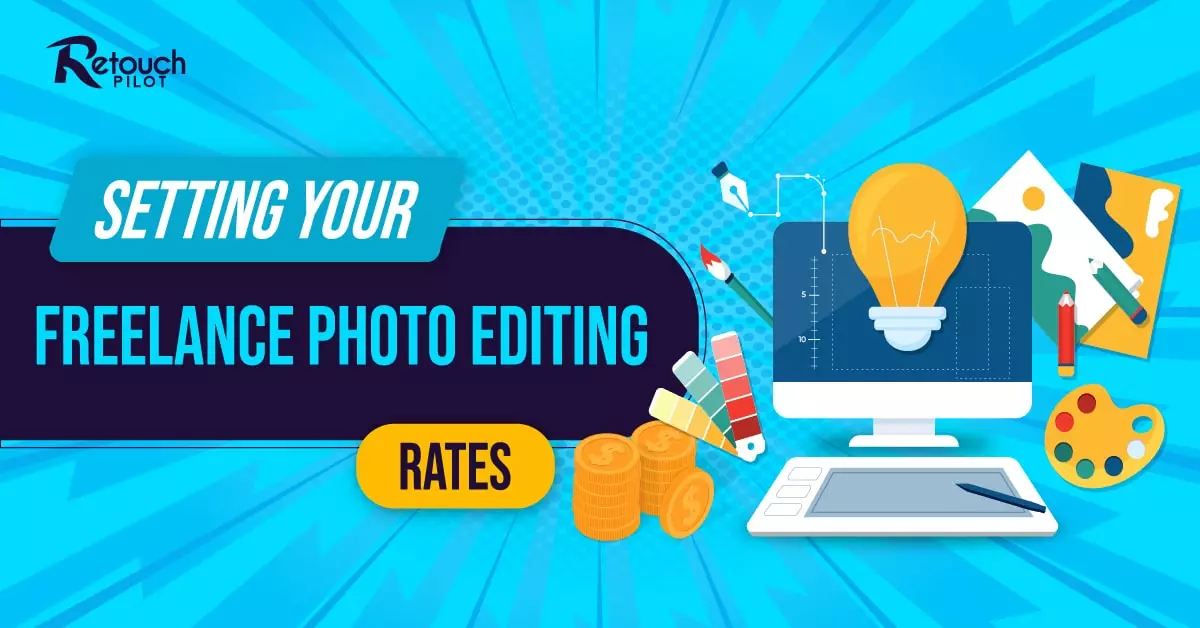Are you a skilled photo editor looking to set your rates but need help with the daunting question of how much to charge for your services? As a freelancer, determining your worth can be a tricky task. You want to set a competitive price but don’t want to undervalue your expertise and experience.
Photo editing refers to altering, retouching, or manipulating digital images using software tools to improve their quality, appearance, and aesthetic appeal.
In this guide, we’ll dive into the factors influencing freelance photo editing rates, giving you the tools to decide what to charge for your services. Whether you’re just starting or a seasoned professional, read on to learn how to price your photo editing skills and maximize your earning potential.
5 Amazing Factors to Consider

We’ll explore some of the most important factors to consider when determining your freelance photo editing rates. So, whether you’re just starting or have been in the industry for a while, read on to learn how to set your rates and take your freelance career to the next level.
- Experience
- Skill Level
- The complexity of the Project
- Client Expectations
- Market Demand
1. Experience
When setting your prices, one of the most important considerations is your Level of professional experience. Starting as a freelance photo editor, you may begin by charging lower fees to build up your portfolio and attract more customers.
On the other hand, if you have several years of experience and have built a track record for delivering high-quality work, you can command higher fees.
2. Skill Level
Your current degree of expertise is another crucial aspect to think about. To succeed as a photo editor, you need to have a keen eye for detail, be fluent in various photo editing applications and have an in-depth knowledge of color theory and composition.
If you have a higher level of expertise, you can command a higher price for your services.
3. Complexity of the Project:
Another issue that should be considered is how difficult the Project is. The editing of many images at once or the retouching of a high-resolution image both involve a significant amount of time and effort, which may do specific projects more time- and labor-intensive than others.
You should set your rates higher to guarantee that you are paid fairly for the time and effort you put into more challenging assignments.
4. Client Expectations:
The expectations of your customers also affect your Pricing. If a customer has specific criteria or expectations regarding the editing process, you may need to invest extra time and effort into meeting those needs.
Be sure that you have a good understanding of what the client anticipates from you, and factor those expectations into your Pricing.
5. Market Demand:
Last but not least, the demand in the market is an essential component to take into account. You’ll be able to charge greater prices for your photo editing services in your region if there’s a significant demand for those services.
On the other hand, if there are already a lot of photo editors in the market, you might need to cut your prices to stay competitive.
4 Types of Pricing Models:

As a freelance photo editor, you have access to various pricing structures, each with advantages and disadvantages. The following is a list of some of the most often-used pricing models:
- Hourly Rates
- Project-based Pricing
- Package pricing
- Value-based Pricing
1. Hourly Rates:
Your customers will be charged a predetermined cost per hour for your photo editing services if you choose this pricing plan.
For projects when it is difficult to determine the exact amount of time required to finish the job, such as when working with new clients, hourly rates are the most suitable pricing structure.
Your Level of experience and the intricacy of the job both play a role in determining your hourly cost, which can range anywhere from $20 to $150 per hour.
Pros:
- Hourly rates provide more flexibility and ensure you’re compensated fairly for your time.
- Hourly rates give clients a clear idea of how much time was spent on a project.
Cons:
- Hourly rates can be unpredictable and may result in lower pay if the Project takes longer than expected.
2. Project-based Pricing:
With project-based Pricing, you charge a fixed fee for the entire Project. This pricing model is ideal for projects where you have a good idea of the time and effort required to complete the job.
Project-based Pricing can range from $50 to $5,000, depending on the scope and complexity of the Project.
Pros:
- Can be more profitable than hourly rates for larger projects
- Encourages efficiency and productivity to complete projects within budget
- Can incentivize long-term client relationships as clients know the cost upfront
Cons:
- If the Project takes longer than expected, you may earn less than hourly rates.
3. Package Pricing:
Offering a predetermined collection of services at a predetermined price is known as “package pricing.”
You may, for instance, provide two different types of packages: a basic one that consists of color correction and cropping for a predetermined charge and a premium one that consists of retouching, background removal, and color grading for a more expensive fee.
Pros:
- It can be easier for clients to understand and choose a package that suits their needs.
- Provides clear expectations for both client and freelancer
- Offers a range of pricing options to attract a wider range of clients
- Encourages repeat business as clients can see the value in multiple packages
Cons:
- Package pricing can be limiting and may not work for all clients or projects.
4. Value-Based Pricing:
Value-based Pricing involves charging based on the value you bring to your clients. This pricing model considers each client’s specific needs, the value of the final product, and the Level of expertise required to complete the job.
Pros:
- Rewards freelancers for their expertise and value
- Allows for more flexibility in Pricing and negotiation
Cons:
- It can be more difficult to determine Pricing upfront, which can be challenging for clients looking for a set price.
Industry Standards
Freelance photo editors must know industry norms for picture editing charges. With this information, you should be able to set reasonable Pricing for your services in line with market standards. According to the standards of the industry, the following are some typical hourly prices as well as project rates:
Hourly Rates:
The average hourly rate for a freelance photo editor ranges from $25 to $75 per hour, depending on the experience level and expertise. Rates can also vary based on geographic location and market demand.
Project-based Pricing:
For project-based Pricing, the average rate ranges from $50 to $500 per Project. This rate can vary based on the complexity of the Project and the amount of time and effort required to complete it.
It’s important to remember that these rates are just guidelines, and it’s up to you to set your rates based on your experience, skills, and market demand. While being competitive is essential, only undervalue your work or charge less than you deserve.
Negotiation Strategies:
Freelance photo editors may find it difficult to negotiate fees for their services, but it is essential to do so to guarantee that they are adequately reimbursed for their efforts. The following are some tactics that can be helpful during negotiations:
Set Clear Boundaries:
Establishing clear boundaries with the client before beginning a project is vital and should be done as early as possible.
Defining the scope of the Project, the deliverables that are anticipated, and the timeline for its completion are all included in this step. You may avoid scope creep and ensure that you are paid for your labor if you define these restrictions at the beginning of the Project.
Be Confident in Your Pricing:
You must have complete faith in the Pricing you provide and the value you add to the Project. It is not in your best interest to undervalue your job or to agree to reduce charges to secure the assignment.
Remember that your time and talent are precious resources that warrant being compensated adequately for their use.
Negotiate from a Position of Strength:
You must have complete faith in the Pricing you provide and the value you add to the Project. It is not in your best interest to undervalue your job or to agree to reduce charges to secure the assignment. Remember that your time and talent are precious resources that warrant being compensated adequately for their use.
Final Words:
In conclusion, determining how much to charge for freelance photo editing services can be challenging, but considering your experience level, the type of services you offer, turnaround time, industry rates, pricing models, and additional services can help you determine fair and competitive rates. Remember to clearly communicate your rates to clients and be open to negotiation and discussion to ensure that you and your clients are satisfied with the pricing arrangement.























